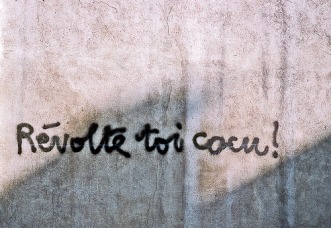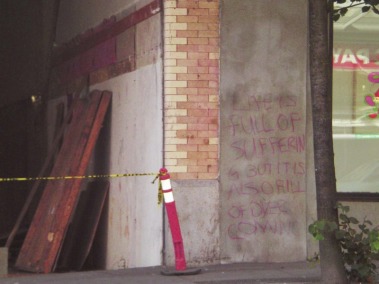graffiti: reasons
political
- As graffiti artists/writers often remain anonymous, many of them are able to express their opinions about politics freely, without the fear of backlash or punishments from authority.
- Graffiti with politic motifs often exist in word and slogan form on building walls and in both private and public properties. However, many also exist in image forms as well.
- Those oppressed, whether due to racial, ethnic, cultural, sex, class or age differences, used this form of political movement not only to mass promote their opinions, but it is used to also gain popularity for their movements against the government or a certain political party.
- The visibility of graffiti in public spaces also instills fear in the government, as it indicates that a portion of the public feels dissatisfied with the government’s political actions.
fame & popularity
- Graffiti artists create tags, personal signatures or distinguishable features that allows them to gain popularity and recognition from those who view their art. These types of artist, although they may choose to remain anonymous, begin to create an identity and reputation for themselves.
- Some graffiti artist can become popular that they are accepted in society. An example of this is the artist Fafi. Read more about her here, here and here.
- Fafi began her artwork as graffiti on the walls of buildings. Years after, due to her signature tag "fafi" and the popularity of her artwork, she soon began to collaborate with companies, such as M.A.C. and created products that are accepted in mainstream society.
expression of the self
- At times, graffiti may not have any hidden motifs or serve any purpose, other than to express one's concerns, thoughts, and feelings.
- This type of graffiti usually are written in words and reveals a "secret" from the graffiti artist/writer. As a result, the canvas in which these types of graffiti are drawn or written on and act as a public "diary".
- This type of graffiti has a binary purpose. It does not only allow the graffiti artist/writer to express his or her's concerns, but it also invites others to participate in it. Even if others do not participate in what is being drawn/written, those who read the graffiti, whether voluntarily or involuntarily, are part of the original graffiti artist/writer's secret, and thus, becomes part of that community.
Red Cat Red Room's Washroom Stall (Flikr):
"I'm feeling pretty good about myself tonight...and that's rare."
"I'm feeling pretty good about myself tonight...and that's rare."
culture of generosity
- A term coined by Clay Shirky, which is how the internet creates a culture of generosity, where information is made public and shared amongst all users. Watch the video here.
- Clay Shirky believes this to be a "cognitive surplus," which represents the ability of the world population to volunteer and to contribute and collaborate on sometimes large, global projects.
- Applying the same concept, graffiti can exist purely to support, encourage, and provide positive messages to those who read it. The graffiti artist gains nothing from the artwork, as they often remain anonymous. However, the impact of the message can change the feelings and emotions of those who view it.
- This type of graffiti has what what Clay Shirky calls "civic value," which is something that is "created by the participants but is enjoyed by society as a whole."
Building near 560 Seymour Street, Vancouver
(July 21, 2010 - Anita Cheong):
"Life is full of suffering but it is also full of over coming"
(July 21, 2010 - Anita Cheong):
"Life is full of suffering but it is also full of over coming"
The Social Nature of Graffiti
- Graffiti is often a means of communication for gangs. It acts as a bulletin board for communicating challenges, warnings, and pronouncement of deeds that are accomplished or about to occur. Graffiti can be used as a secret language code for gangs or sub-groups.
- Graffiti is ironically seen as an "anti-social" activity by governmental authorities and most citizens because it defies social conventions and is a form of rebellion.
- According to an ex-graffiti artist, one must understand his or her own motives and not create graffiti simply to destroy public space. An artist must have a clear motive, whether it is to communicate a social/political/religious message, to shock or amuse people, or merely to defy legal authorities.





